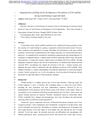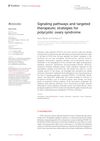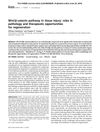Anti-Ku Antibodies: Much More Than Scleromyositis
June 2020
in “
Annals of the Rheumatic Diseases
”

TLDR Patients with Systemic Sclerosis have much higher levels of GDF-15, which could help predict organ involvement and guide treatment.
In a study involving 42 patients with Systemic Sclerosis (SSc), researchers discovered that these patients had significantly higher levels of Growth Differentiation Factor 15 (GDF-15) compared to 42 healthy controls, with a strong statistical significance (p<0.001). The elevated GDF-15 levels were linked to various clinical features of SSc, including diffuse SSc, pulmonary arterial hypertension, interstitial lung disease, reduced forced vital capacity, high serum titles of antiScl70, increased disease activity, and capillary dilations observed in capillaroscopy. Conversely, no significant differences were observed in the levels of CXCL4 and CXCL8 between the SSc patients and the healthy controls. Nonetheless, CXCL4 was associated with the consumption of complement C3 fraction and skin involvement in SSc patients. The findings indicate that GDF-15 could serve as a valuable biomarker for SSc, aiding in the prediction of organ involvement and informing diagnostic and therapeutic strategies.



